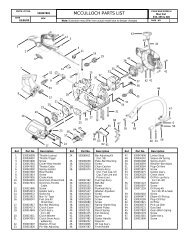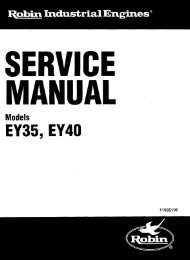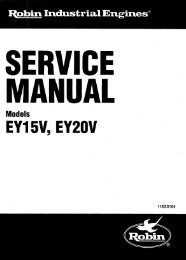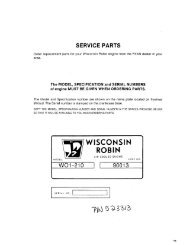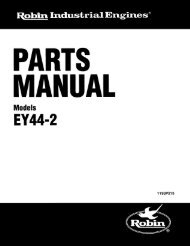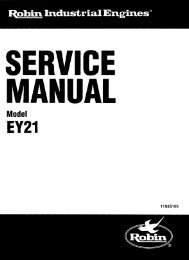4-CYCLE OVERHEAD VALVE ENGINES - Small Engine Discount
4-CYCLE OVERHEAD VALVE ENGINES - Small Engine Discount
4-CYCLE OVERHEAD VALVE ENGINES - Small Engine Discount
Create successful ePaper yourself
Turn your PDF publications into a flip-book with our unique Google optimized e-Paper software.
10 Amp A.C. Alternator<br />
CHECKING THE SYSTEM: Unplug the connector at<br />
the wiring harness supplied by the OEM. Proceed to<br />
make an A.C. output check. Place one lead of the<br />
A.C. voltmeter on the center plug of the connector.<br />
Place the other lead to engine ground (diag. 22).<br />
With the engine running, minimum values should read:<br />
2500 R.P.M. - 16.0 Volts A.C.<br />
3000 R.P.M. - 20.0 Volts A.C.<br />
3300 R.P.M. - 22.0 Volts A.C.<br />
If less than above output, the alternator assembly is<br />
defective. See Chapter 9 for "Disassembly<br />
Procedure".<br />
16 Amp Alternator System with External Regulator<br />
A.C. OUTPUT<br />
YELLOW<br />
CHECKING THE SYSTEM: An open circuit D.C. voltage check cannot be made with this system. If a known<br />
good battery fails to maintain a charge, proceed to make an A.C. voltage test.<br />
Disconnect the red D.C. output connector at the wiring harness and connect the probes from an A.C. voltmeter<br />
to the wire terminals at the regulator-rectifier.<br />
With the engine running, minimum values should read:<br />
2500 R.P.M. - 21 Volts A.C.<br />
3000 R.P.M. - 26.5 Volts A.C.<br />
3600 R.P.M. - 31.0 Volts A.C.<br />
If the minimum values are noted, the alternator is<br />
operating properly. If less than the above values are<br />
noted, the alternator is defective.<br />
VOLTAGE REGULATORS<br />
If a known good or load tested battery fails to maintain<br />
a charge, the charging system and the regulator can<br />
be checked using a voltmeter. Set the voltmeter on<br />
the 0-20 Volt D.C. scale and connect the probes<br />
across the battery terminals. Note the battery voltage.<br />
Start the engine, the voltage reading should increase<br />
from the noted battery voltage but not exceed 15 Volts<br />
D.C. If no voltage increase is noted, proceed to make<br />
an A.C. voltage check using the applicable procedure.<br />
If the battery voltage exceeds 15 Volts D.C., or the<br />
proper minimum A.C. voltage is noted during the<br />
check, replace the regulator (diag. 23).<br />
FUEL SHUT-DOWN SOLENOIDS<br />
If the engine is running, the solenoid can be checked<br />
by removing the electrical plug-in at the base of the<br />
solenoid. Almost immediately the engine should shut<br />
down, if not replace the solenoid.<br />
D.C. OUTPUT - RED<br />
FUSE<br />
REGULATED<br />
D.C. OUTPUT<br />
YELLOW<br />
Test the solenoid off the carburetor by applying 12<br />
volt D.C. from the battery positive terminal to the (or<br />
one) solenoid terminal. Connect a jumper wire from<br />
the metal housing (or other terminal) to a negative<br />
battery terminal. The plunger should retract the full<br />
travel distance. Disconnect the negative jumper lead<br />
and the plunger should return to the extended position.<br />
Replace if necessary (diag. 24).<br />
SINGLE<br />
Not For Resale<br />
46<br />
GREEN<br />
MAGNETO<br />
GROUND<br />
BATTERY<br />
SOLENOID<br />
AMMETER<br />
A.C.<br />
SWITCH<br />
RED<br />
NOTE: D.C. OUTPUT MUST BE DISCONNECTED TO<br />
PERFORM A.C. OUTPUT TEST.<br />
www.<strong>Small</strong><strong>Engine</strong><strong>Discount</strong>.com<br />
DOUBLE<br />
22<br />
LIGHT<br />
23<br />
24





